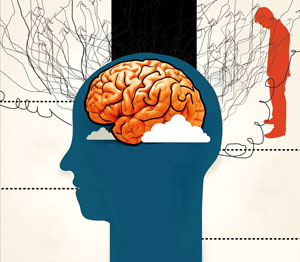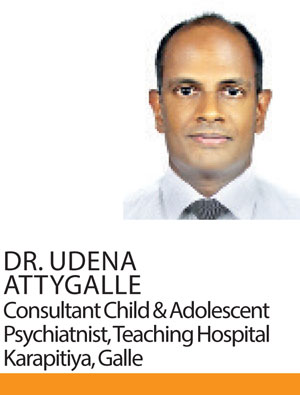18 Aug 2017 - {{hitsCtrl.values.hits}}
 Have you ever worried before sitting for a test or when faced with a problem at work? Or even before making an important decision? Well it’s very normal to feel anxious over an issue and everybody has experienced anxiety. However some of us experience anxiety disorders where the constant feeling of overwhelming worry and fear can be disabling. Speaking to the Health Capsule, Dr Udena Attygalle, Consultant Child and Adolescent Psychiatrist, Teaching Hospital Karapitiya, Galle explained that anxiety isn’t all bad, it can sometimes be a protective even an evolutionary function that keeps us away from danger. Dr. Attygalle further explained the difference between normal anxiety and a disorder and how we can regulate it and use it to our advantage.
Have you ever worried before sitting for a test or when faced with a problem at work? Or even before making an important decision? Well it’s very normal to feel anxious over an issue and everybody has experienced anxiety. However some of us experience anxiety disorders where the constant feeling of overwhelming worry and fear can be disabling. Speaking to the Health Capsule, Dr Udena Attygalle, Consultant Child and Adolescent Psychiatrist, Teaching Hospital Karapitiya, Galle explained that anxiety isn’t all bad, it can sometimes be a protective even an evolutionary function that keeps us away from danger. Dr. Attygalle further explained the difference between normal anxiety and a disorder and how we can regulate it and use it to our advantage.
Definition

While anxiety is a normal reaction to certain stressful situations, it becomes a “disorder” when the anxiety is disabling. So while having worries about the future is normal ( and useful at times!) if these fears become so paralysing that you are unable to carry on with your day to day work for an extended period of time, it may fall within the category of an anxiety disorder. Thus, while some anxiety may even have a protective function e.g. fear of heights might protect you from taking unnecessary risks, when it is at the level of a disorder it will likely impede your day to day work, e.g. so distressed by fear of heights that you are unable to even to go to the upper floor of your own house.
Although this is a simplified way of looking at it, anxiety disorders have certain characteristics that your doctor will be able to identify. Of all the mental health conditions anxiety disorders are one of the more common conditions. When anxiety affects children, it may have adverse effects on other aspects of their development. Thus, a child who is anxious may have difficulties making friends, concentrating in class and learning to separate from their parents. These are invariably important for the future development of the child.
The types
There are many types of anxiety disorders. Some of them are as follows.
Generalized anxiety disorder is where anxieties are many and not restricted to any particular environmental circumstances.

Social Phobia often start in adolescence and revolves around fears of be evaluated in social situations.
The Specific phobias are restricted to highly specific situations. Thus, the anxieties about heights, flying, closed spaces etc. would fall into this category.
Agoraphobia is the fear of being unable to escape from places such as open spaces or even crowds. When the condition is severe the affected ones can even be restricted to their homes, because of their fears of being outside and being unable to escape to a safe place.
In Panic Disorder the essential features are recurrent attacks of severe anxiety (panic) at which point those afflicted feel so fearful that they may even fear that they are going to die. While they are relatively symptom free between episodes they live with constant anticipatory anxieties about getting another episode.
While all the above disorders can happen in childhood and adolescence, agoraphobia is relatively rare in these age groups. However in children there can be other manifestations of anxiety such a as separation anxiety disorder that are specific to childhood. The key feature is excessive anxiety concerning separation from those they are attached to (usually parents). In this condition they may refuse to go to school, have difficulties falling asleep without the person they worry about.
The symptoms
To simplify things symptoms could be divided in to 3 categories- physical symptoms, cognitive symptoms and avoidance. The physical symptoms would include palpitations, breathlessness, sweating etc. The cognitive symptoms would include a sense of worry, and forebodings. Avoidance is characterised by avoiding the things that make them anxious. In children anxiety is mostly evident by avoidance, physical symptoms and in other behaviours. For example, a child who is anxious about school might avoid school, he might also manifest physical symptoms like stomach aches in the morning before school.

Treatment
This is usually a combination of medication, psychotherapy and environmental modifications. Medication too is an important option, but has to be used regularly as prescribed to gain maximum benefit.
The psychotherapy work usually involves thinking differently about issues and reducing the avoidance seen in anxiety. Especially in the case of children family intervention such as getting the parents to respond differently to their children may be important. In essence the goal is to give those afflicted the experience that they can manage the distress and anxiety and that they do not need to avoid it.
Environmental modification may be especially important in children. An example being a mother with a child with separation anxiety who makes arrangements so that she can spend more time with the child. Other examples include scheduling in activities that are pleasurable in to the daily routine of those with anxiety disorders. This is important as the anxieties can in a way take over and feel insurmountable.
Prevention
It is probably impossible, and not really necessary to avoid anxieties completely. This is as anxieties have a protective function and some believe an evolutionary function in keeping us away from dangers e.g. we are scared and anxious of snakes, (even the non-venomous ones)
But it may be important to be able to understand, regulate and use our anxieties in a way that lead to positive outcomes. This is a part of what is described as emotional intelligence.
Thus while a deadline can make you anxious, if you are able to regulated it and manage it in such a way that it’s not distressing but useful in getting the work done, then you would have been able to use the anxiety to gain something positive. This is a part of emotional intelligence. Yerkes Dodson’s curve describes the relationship between performance and the level of anxiety. So while we do need some anxiety to perform well too much anxiety impairs performance. It may be especially important for parents to keep this in mind and help their children and adolescent to regulate their anxieties so that it does not become unbearable. And also help them communicate to you if they do become unbearable, so that help can be arranged.
It is also important that parents are able to contain their own anxieties when it comes to children and adolescents. This not only gives them a model on how to manage their own anxieties, but also gives them the confidence to come to their parents with their own worries (knowing that they will be able to handle it!).
23 Dec 2024 2 hours ago
23 Dec 2024 3 hours ago
23 Dec 2024 6 hours ago
23 Dec 2024 7 hours ago